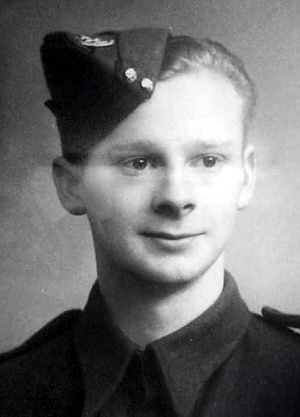
George Alfred Ashton was born in Ossett on the 13th July 1918, the son of butcher Charles Ashton (1889-1953) and his wife Beatrice Maude, nee Lucas (1890-1965) who had married on the 1st October 1912 at St. Michael’s Church, Wakefield.
The Ashton family lived at Crown Lands Cottages, Kingsway, Ossett (now 100 Kingsway). George’s father Charles was the manager of the Ossett Co-op butchery department.
On July 15th, 1939, just two days after his 21st birthday, George Alfred Ashton enlisted at Pontefract “for the duration of the emergency”. George joined the Hallamshire Infantry Battalion of the York and Lancaster Regiment.
The Hallamshire Battalion, York and Lancaster Regiment, 146th Infantry Brigade, 49th (West Riding) Division were a part of Mauriceforce (Norwegian Campaign) in Norway in April 1940. The Hallamshire Battalion were ashore in Norway for twelve days seeing limited action and losing their only casualties on the journey home when one of their transports was sunk.
The battalion spent the next two years defending Iceland before returning to Scotland for garrison duties and to prepare for the invasion of North West Europe. The Hallamshires landed in France on the 9th June 1944 with the 49th Infantry Division and moved into the front line four days later. George Ashton was a part of the Iceland ‘C’ Force. Throughout the war, British officers referred to the country as Iceland (C) on Churchill’s orders because, early in the war, someone had mistakenly sent a ship to Ireland instead of Iceland.
The invasion of Iceland was a British military operation conducted by the Royal Navy and Royal Marines during World War II to occupy and deny Iceland to Germany. On the 9th April 1940, Germany overran Denmark, Iceland’s former mother country, whose king was still the Icelandic head of state. After failing to persuade the Icelandic government to join the Allies, the British invaded on the morning of the 10th May. The initial force of 746 British Royal Marines commanded by Colonel Robert Sturges disembarked at the capital Reykjavík. Meeting no resistance, the troops moved quickly to disable communication networks, secure strategic locations, and arrest German citizens.
On the 17th May 1940, the British 146th Infantry Brigade, arrived to relieve the Royal Marine invasion force, who left on the 19th May. British Army staff based in Akureyri formed the Tactical School, Winter Warfare Course, which trained the 49th into a Mountain/Arctic division. Additional reinforcements over the course of the summer included field artillery, Anti-Aircraft guns, Bren carriers, engineer and construction units, and support forces. The final British ground reinforcements, an infantry battalion and artillery battery, arrived in June 1941. By July 1941, there were over 25,000 British troops on the island.
In late 1942, George was seconded to Catterick as a Signals instructor. Later he rejoined his battalion in France. A month later in August 1944 he was wounded after being accidently shot in the thigh with a sten gun by another British soldier. After extensive hospital treatment for a compund fracture of his right femur, he was eventually sent back home to England. The wound left Sergeant Ashton with a slight limp for the rest of his life.

Above Top: George Ashton (front row, first left) during his service in Iceland with Hallamshire Battalion dressed in winter battle dress. Above Lower: George Ashton is pictured bottom row, seated, furthest right with his Hallamshire Battalion colleagues.

Above: George Ashton shown centre outside his WW2 accommodation in Iceland. The picture on the right shows the inside of the same building.

Above Left: George Ashton with his bride Doreen Tyson on their wedding day in 1945. Above Right: George Ashton pictured centre during his time with Hallamshire Battalion in Iceland.
George Ashton married Doreen E. Tyson on the 15th December 1945 in Ossett and had four children: Jaqueline Susan, born in 1946; Joan E., born in 1950; Stephen R., born in 1952 and Doreen V., born in 1955, all born in the Ossett area apart from Jacqueline, who was born in East Yorkshire. Eleven years later, on the 31st May 1956, George and Doreen with their family of four children emabarked on the S.S. “Southern Cross” for Capetown, South Africa where they were to start a new life. At the time, all the children were under 10 years of age and their youngest child was less than a year old.
The Ashton family subsequently moved to New Zealand where, in 1977, George and Doreen were given citizenship. George Alfred Ashton died in Auckland, New Zealand on the 18th August 2002.
References:
1. Thanks to Richard Ashton, the grandson of George Ashton who kindly allowed the use of the pictures from his grandfather’s collection.